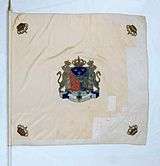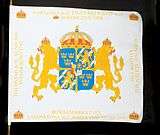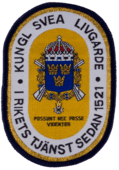Svea Life Guards
Coordinates: 59°30′56″N 17°46′10″E / 59.51556°N 17.76944°E
| Svea Life Guards | |
|---|---|
| Svea livgarde | |
 | |
| Active | 1521–2000 |
| Country |
|
| Allegiance | Swedish Armed Forces |
| Branch | Swedish Army |
| Type | Infantry regiment |
| Size | Regiment |
| Part of |
Milo Ö (1942–1991) Milo M (1991–2000) |
| Garrison/HQ |
Stockholm (1843–1946) Solna (1947–1970) Kungsängen (1970–2000) |
| Motto(s) |
Possunt nec posse videntur ("They do what appears to be impossible")[note 1] |
| Colors | Yellow |
| March |
"Kungl. Svea Livgardes Marsch" (W. Körner) "Kungl. Svea Livgardes Defileringsmarsch" (I. Gustavsson) "Kungl. Svea Livgardes Gamla Marsch, Inspektionsmarsch" (unknown) |
| Battle honours |
Swedish War of Liberation 1521 Rhine 1631 Lützen 1632 Warsaw 1656 March Across the Belts 1658 Halmstad 1676 Lund 1676 Landskrona 1677 Narva 1700 Düna 1701 Kliszów 1702 Holowczyn 1708 Svensksund 1790 |
The Svea Life Guards (Swedish: Svea livgarde), also I 1, was a Swedish Army infantry regiment that was active in various forms 1521–2000. The unit was based in the Stockholm garrison in Stockholm and belonged to the King's Life and Household Troops (Kungl. Maj:ts Liv- och Hustrupper) until 1974.[3]
History
1500s–1900s
Svea Life Guards, the Swedish Army's first guard infantry regiment, originated from the Trabant Corps that surrounded the first Vasa Kings and is said to have been formed in 1526. The Trabant Corps seems to have, at least in part, been included in the enlisted regiment established in 1613, which consisted mostly of Germans, which under the names of the King's Life and Court Regiment (Konungens liv- och hovregemente), the Yellow Regiment (Gula regementet) and the Yellow Brigade (Gula brigaden) participated in Gustavus Adolphus' campaign in Germany. The regiment's first two companies formed the king's lifeguard and consisted mostly of Swedes. The 60 survivors of the guard after the Battle of Lützen, followed the king's corpse to Sweden, after which the guard, whose staff has been increased to 148 men, united in 1644 with one established regiment in the Baltic governorates and one established regiment in Svealand into a large court regiment of which Magnus Gabriel De la Gardie was the commander.[4]
Most of the regiment was disbanded after 1660, but the part still in Sweden was developed into a Guard or Court Regiment. Eventually increased to 24 companies, it participated in Charles XII's War and was lost after the Battle of Poltava, but was then reestablished. The Life Guards as the regiment then was commonly known, was given the name Svea Guards (Svea garde) in 1792.[4] The regiment had its barracks at Fredrikshov Castle in Östermalm, Stockholm from 1802.[5] In 1808 it lost for a short time its dignity of being a guard and was then called Fleetwood's Enlisted Regiment (Fleetwoodska värvade regementet). It was in 1809 again called Svea Guards (Svea garde) and received the name Svea Life Guards (Svea livgarde) the same year. From having been divided into 10 companies of 80 men, the regiment was in 1831 divides into eight companies with a total of 820 men. After the 1901 Defence Bill it increased into 12 companies (three battalions) and 1 machine gun company, but its number strength of volunteers was reduced to 555 men (music staff included) and after the 1914 Defence Bill further to 540 men.[4]

Svea Life Guards was an enlisted regiment and its staff, which was stationed in the barracks at Fredrikshov, was permanently employed. In the early 1800s compulsory military service in Sweden was introduced on a modest scale.[6] As a result of the increased multiform unrest in Europe during the 1850s, it increased the conscripts appropriated exercise period from 12 to 30 days, spread over the first two years of conscript military service. These exercises took place during the summer. However, when the space in the barracks was too small to accommodate these conscripts, they were placed in bivouac shelters at Ladugårdsgärdet.[6] The cramped space at Fredrikshov and the unhygienic conditions there and the ever-increasing need to place conscripts in barracks, forced the decision on the construction of modern barracks for the two foot guards regiments, Svea Life Guards and Göta Life Guards. It was decided that the plateau above Fredrikshov, was the most well-situated location for the barracks, adjacent to the large practice field, which northern Djurgården then still was.[6] Palace intendant, Professor Ernst Jacobsson, was instructed to carry out the drawings and in the autumn of 1888 Svea Life Guards could during great celebrations, led by their head, King Oscar II, take possession of their new barracks.[6]
1900s–2000s

In the early 1940s the decades ago planned relocation of the regiment to Järvafältet became reality. On 5 October 1946 the Svea Life Guards officially left its barracks at Linnégatan in Östermalm, Stockholm and this took place at a ceremony in the park at the memorial stone. The then executive officer, colonel Gösta von Stedingk handed the memorial stone over to the City of Stockholm, represented by the municipal commissioner of the Stockholm Central Board of Administration (Stadskollegium), Yngve Larsson. It then left Stockholm which had been its location for more than 400 years.[7] The regiment moved in 1947 to Sörentorp in Solna. The design of the area was carried out by the Royal Fortifications Administration. The area was given a relatively free pooled plan, and Bertil Karlén was the architect of the buildings.[8] In 1970 Svea Life Guards moved again, this time to an area at Granhammar Castle in Kungsängen.[8]
From 1975 to 1984, the regiment's duties were maintain a number of military units in the war organization and conduct war planning for these. The regiment was also responsible for Kungsängen's barracks area with associated exercise and firing range as well as some support to other units in the garrison.[9] Included in the maintenance of war units were basic recruitment of officers but internal officer training and education of the conscripts. Officer training was also carried out to maintain the war units. The regimental staff and training units also participated extensively in state ceremonial activities on behalf of the Chief Commandant and the Commandant in Stockholm.[9] The regiment consisted mainly of a staff, a training unit, including a training battalion and department for management of exercises and firing range, and a support unit with subdivisions. The Swedish Armed Forces ABC-Defence School was located in Kungsängen and was included as a section in the unit.[9]
On 1 October 1984 the Life Guard Dragoons with Stockholm Defence Area (K 1/Fo 44) was disbanded, and Svea Life Guards was renamed Svea Life Guards with Stockholm's Defense Area (I 1/Fo 44). The regiment took over the task as lower regional head of the Stockholm Defense Area as well as the maintenance of cavalry troops in war organization. The regimental commander was the Commandant in Stockholm. The regiment consisted of a staff, a unit of territorial management, a training unit, including two training battalions and one support unit with subdivisions. The duties of the regimental commander as the Commandant in Stockholm, notably to state ceremonial activities, were coordinated by a garrison unit located at the Stockholm Palace in Stockholm.[9] On 1 July 1994 the Life Guard Dragoons were separated and again became an independent unit.[9] Svea Life Guards was disbanded in 2000 and re-emergenced the same year as the Life Guards (LG).
Heraldry and traditions
Banners
On 30 April 2000, King Carl XVI Gustaf at the Stockholm Palace (in connection with his birthday) handed over the regiment's last banner. The banner has since 1 July 1994 been carried by both the Svea Life Guards and the Life Guards Brigade. The 2000 banner replaced the 1964 banner, which had been handed over the Stockholm Palace by King Gustaf VI Adolf. After the Svea Life Guards was merged with the Life Guard Dragoons and formed the new unit, the Life Guards, the Guards Battalion at the Life Guards now carried the banner.[10] The regiment's life company carried its own banner, which in the years 1994-2000 was carried by the Life Guards Brigade.
|
Unit designations and insignias
Unlike the other infantry and armor regiments, which have a constant unit designation, the Svea Life Guards has the Swedish monarch's monogram.[10]
|
Medals
In 1921 the Royal Svea Life Guards 400-year Anniversary Medal in Silver (Kungliga Svea livgardes 400-åriga jubileumsmedalj i silver, SLMSM) was instituted. This medal was instituted as a commemorative medal when the regiment was disbanded on 30 June 2000.[11] In 1999 the Svea Life Guards and the Life Guards Brigade Medal of Merit in Gold and Silver (Svea livgardes och Livgardesbrigadens förtjänstmedalj i guld och silver, SvealivgLivbrigGM/SM) was instituted.[12][13]
|
Commanding officers
Regimental commanders and executive officers (Sekundchef) active at the regiment. On 11 March 1774, King Gustav III himself took over as commanding officer of the regiment, but left the actual command of it to the executive officer. This was subsequently done to all units within the King's Life and Household Troops (Kungl. Maj:ts Liv- och Hustrupper) which until 1974 had each an executive officer and the king as joint commander. Sekundchef was a title which was used until 31 December 1974 at the regiments that were part of the King's Life and Household Troops.[3]
Commanding officers (1657–1774)

- 1696–1706: Knut Posse
- 1706–1712: Carl Magnus Posse
- 1712–1712: Jakob Grundel
- 1712–1717: Gabriel Ribbing
- 1717–1727: Michael Törnflycht
- 1727–1739: Arvid Posse
- 1739–1744: Otto Wrangel
- 1744–1751: Adolf Frederick
- 1751–1756: Per Gustaf Pfeiff
- 1756–1772: Axel von Fersen
- 1772–1772: Carl Ehrenkrook (acting)
- 1772–1774: Jacob Magnus Sprengtporten
Executive officers (1774–1974)
- 1774–1774: Carl Ehrenkrook (acting)
- 1774–1776: Jakob Leonard König
- 1776–1788: Carl Aminoff
- 1788–1796: Bror Cederström
- 1796–1796: Fabian von Fersen
- 1796–1797: Wilhelm Bennet
- 1797–1802: Adolf von Friesendorff
- 1802–1808: Carl Carlsson Mörner
- 1808–1809: Carl Johan Fleetwood (regimental commander)[note 2]
- 1809–1811: Carl Carlsson Mörner
- 1811–1815: Johan August Sandels
- 1815–1837: Carl Lovisin
- 1837–1843: Sixten Sparre
- 1843–1849: Adolf Axel Lovisin
- 1849–1853: Nils Gyldenstolpe
- 1853–1862: Carl Henric Möllerswärd
- 1862–1873: Gösta Leijonhufvud
- 1873–1887: Roger Björnstjerna
- 1888–1892: Henric Ankarcrona
- 1892–1896: Hemming Gadd
- 1896–1897: Carl Lagercrantz
- 1897–1902: Gustaf Uggla
- 1902–1909: Carl Rosenblad
- 1909–1915: Hugo Hult
- 1915–1920: John Montgomery
- 1920–1923: Ernst Silfverswärd
- 1923–1928: Oscar Nygren
- 1928–1936: Carl Tersmeden
- 1936–1938: Hugo Cederschiöld
- 1938–1942: Henry Tottie
- 1941–1942: Einar Björk (acting)
- 1942–1943: Einar Björk
- 1943–1946: Sven Ramström
- 1946–1950: Gösta von Stedingk
- 1950–1953: Thord Bonde
- 1953–1957: Malcolm Murray
- 1957–1965: Sten Langéen
- 1965–1966: Fredrik Löwenhielm
- 1966–1972: Sten Ljungqvist
- 1972–1974: Bengt Hallenberg
- 1974–1974: Bengt Selander
Commanding officers (1975–2000)
- 1975–1980 – Bengt Selander
- 1980–1987 – Rolf Frykhammar
- 1987–1992 – Jan-Olof Borgén
- 1992–1994 – Göran De Geer
- 1994–1997 – Markku Sieppi
- 1997–2000 – Kim Åkerman
Name, designation and garrison
| Kungl Drabanterna | Royal Trabants | 1523 | – | 1618 |
| Kungl Hovregementet | Royal Court Regiment | 1618 | – | 1649 |
| Kungl Maj:ts garde och livregemente | Royal Majesty Guards and Life Regiment | 1649 | – | 1655 |
| Kungl Maj:ts livgarde till häst och fot | Royal Majesty Mounted Life Guards and on Foot | 1655 | – | 1675 |
| Kungl Maj:ts livgarde till häst och fot | Royal Majesty Mounted Life Guards and on Foot | 1675 | – | 1700 |
| Kungl Maj:ts Livgarde till fot | Royal Majesty Life Guards on Foot | 1700 | – | 1709-07-01 |
| Kungl Maj:ts Livgarde till fot | Royal Majesty Life Guards on Foot | 1709 | – | 1792 |
| Kungl Maj:ts första livgarde | Royal Majesty First Life Guards | 1791 | – | 1792-08-09 |
| Kungl Svea livgarde | Royal Svea Life Guards | 1792-08-10 | – | 1806-06-14 |
| Kungl Livgardet till fots | Royal Life Guards on Foot | 1806-06-15 | – | 1808-10-12 |
| Kungl Fleetwoodska regementet | Royal Fleetwood Regiment | 1808-10-13 | – | 1809-03-12 |
| Kungl Svea livgarde | Royal Svea Life Guards | 1809-03-13 | – | 1974-12-31 |
| Svea livgarde | Svea Life Guards | 1975-01-01 | – | 1984-09-30 |
| Svea livgarde med Stockholms försvarsområde | Svea Life Guards and Stockholm Defence Area | 1984-10-01 | – | 2000-06-30 |
| No 1 | 1816-10-01 | – | 1914-09-30 |
| I 1 | 1914-10-01 | – | 1984-09-30 |
| I 1/Fo 44 | 1984-10-01 | – | 2000-06-30 |
| Stockholm/Fredrikshov Castle (G) | 1803-10-01 | – | 1888-10-30 |
| Stockholm/Garnisonen (G) | 1888-10-31 | – | 1946-09-30 |
| Solna/Sörentorp (G) | 1946-04-04 | – | 1970-06-30 |
| Kungsängen Garrison (G) | 1970-07-01 | – | 2000-06-30 |
| Stockholm/Life Guards Cavalry Barracks (D) | 1970-07-01 | – | 2000-06-30 |
| Södertälje/Almnäs (D) | 1994-07-01 | – | 2000-06-30 |
| Ladugårdsgärdet (T) | 1803 | – | 1905 |
| Järvafältet (T) | 1905 | – | 1970-06-30 |
| Kungsängen training and firing range (T) | 1970-07-01 | – | 2000-06-30 |
See also
Footnotes
- ↑ Svea Life Guards' motto is Possunt nec posse videntur and is translated by the Svea Life Guards to "modern Swedish" as De gör det som syns vara omöjligt ("They do what appears to be impossible").[1] A more literal translation is De kan, de ser inte bara ut att kunna or De kunna, ehuru de synas icke kunna ("They could, though they seem to not be able").[2]
- ↑ Carl Johan Fleetwood was the regimental commander from 12 October 1808 to 9 April 1809 because the regiment was deprived of the rank of a guard regiment.[3]
References
Notes
- ↑ "Valspråk". Livgardets historik (in Swedish). Swedish Armed Forces. Retrieved 2011-01-01.
- ↑ Sveagardesföreningen.
- 1 2 3 Kjellander 2003, p. 313
- 1 2 3 Westrin 1918, pp. 888–889
- ↑ Mellin 1841, p. 89
- 1 2 3 4 Lagerberg 1967, pp. 47–48
- ↑ Lagerberg 1967, p. 54
- 1 2 Malmlöf 1989
- 1 2 3 4 5 Ihrén 2001
- 1 2 Braunstein 2003, pp. 25–29
- ↑ "LGISM" (in Swedish). Medalj.nu. Retrieved 14 March 2017.
- ↑ "LGIGM" (in Swedish). Medalj.nu. Retrieved 14 March 2017.
- ↑ "LGISM" (in Swedish). Medalj.nu. Retrieved 14 March 2017.
- Braunstein, Christian (2003). Sveriges arméförband under 1900-talet. Skrift / Statens försvarshistoriska museer, 1101-7023 ; 5 (in Swedish). Stockholm: Statens försvarshistoriska museer. ISBN 91-971584-4-5. LIBRIS 8902928.
- Kjellander, Rune (2003). Sveriges regementschefer 1700-2000: chefsbiografier och förbandsöversikter (in Swedish). Stockholm: Probus. ISBN 91-87184-74-5. LIBRIS 8981272.
- Lagerberg, Sven (1967). Livgardet i Stockholm: en stockholmskrönika (PDF). Stockholms stadsmuseums småskrifter, 99-0876027-0 ; 5 (in Swedish). Stockholm. LIBRIS 858012.
- Malmlöf, Maria (1989). Kulturmiljöer i Solna: kulturminnesvårdsprogram för Solna kommun (in Swedish). Solna: Solna kommun. LIBRIS 802540.
- Mellin, Gustaf Henrik (1841). Stockholm and its environs: comprehending the history and curiosities of the capital, and a description of everything remarkable in its neighbourhood. Stockholm: L. Gust. Rylander. LIBRIS 1955501.
- Westrin, Theodor, ed. (1918). Nordisk familjebok: konversationslexikon och realencyklopedi (in Swedish). 27 (Ny, rev. och rikt ill. uppl. ed.). Stockholm: Nordisk familjeboks förl. LIBRIS 8072220.
- Svensk rikskalender 1909 (in Swedish). Stockholm: Norstedt. 1908. LIBRIS 498191.
Web
- Ihrén, Anders (2001-06-11). "Svea livgarde > Förteckning" [Svea Life Guards > List] (in Swedish). National Archives of Sweden. Retrieved 22 December 2016.
- "Sveagardesföreningens FAQ". www.sveagardesforeningen.se (in Swedish). Sveagardesföreningen. Archived from the original on 3 May 2009. Retrieved 23 December 2016.
Further reading
| Wikimedia Commons has media related to Svea Life Guards. |
- Barkman, Bertil C:son, ed. (1937). Kungl. Svea livgardes historia. Bd 1, 1523-1560 (in Swedish). Stockholm: Stift. för Svea livgardes historia. LIBRIS 8201151.
- Barkman, Bertil C:son, ed. (1939). Kungl. Svea livgardes historia. Bd 2, 1560-1611 (in Swedish). Stockholm: Stift. för Svea livgardes historia. LIBRIS 8201147.
- Lundkvist, Sven; Barkman, Bertil C:son, eds. (1963). Kungl. Svea livgardes historia. Bd 3:1, 1611-1632 (in Swedish). Stockholm: Stift. för Svea livgardes historia. LIBRIS 8201150.
- Lundkvist, Sven; Tersmeden, Lars; Barkman, Bertil C:son, eds. (1966). Kungl. Svea livgardes historia. Bd 3:2, 1632(1611)-1660 (in Swedish). Stockholm: Stift. för Svea livgardes historia. LIBRIS 8201149.
- Wernstedt, Folke, ed. (1954). Kungl. Svea livgardes historia. Bd 4, 1660-1718 (in Swedish). Stockholm: Stift. för Svea livgardes historia. LIBRIS 8201148.
- Selander, Bengt, ed. (1976). Kungl. Svea livgardes historia. 5, 1719-1976 (in Swedish). Stockholm: Stift. för Svea livgardes historia. ISBN 91-7260-096-9. LIBRIS 155554.
- Selander, Bengt, ed. (1983). Kungl. Svea livgardes historia. 6, Biografiska uppgifter om regementsofficerskåren 1903-1981 (in Swedish). Stockholm: Stift. för Svea livgardes historia. ISBN 91-970517-0-5. LIBRIS 8201152.
- Engström, Johan (2014). Fritz von Dardel och Kungl. Svea livgarde (in Swedish). Stockholm: Medström. ISBN 9789173291187. LIBRIS 14858026.








